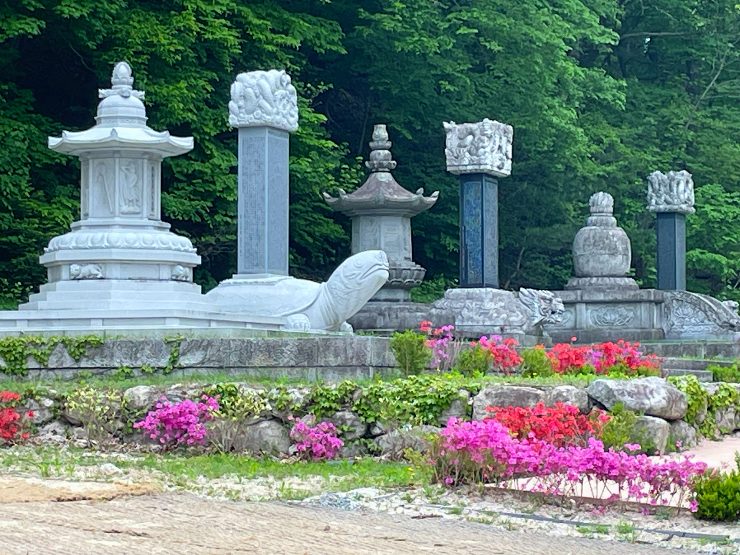There are a few things Korea is known for—such as K-Pop, Korean BBQ, and Kimchi. It’s not usually known for natural beauty. Yet, here at Seoraksan, which translates as Mount Sorak National Park, nature is absolutely stunning. “You’ll see how beautiful and spiritual this park is,” says our guide Michelle Hong of Intrepid Travel, who is leading our tour of South Korea. “There will be mountains, waterfalls, streams running in narrow valleys, ancient temples, remains of a castle, and very pure air.” Our curiosity is piqued, and we excitedly follow her into the park.
It is about two and a half hours by express bus from Seoul to Sokcho, in Gangwon Province, South Korea. As the scenery changes from city to rolling hills with seaside views, city tensions are left behind.
By 9 a.m., we entered Seoraksan National Park, the trail map in one hand, ears open to Michelle and curiosity piqued.
7th Century Zen Temple

The first stop was Sinheungsa, one of the oldest Zen temples in the world, said to date back to the 7th century. This is a head temple of the Jogye Order of Korean Buddhism, nestled on the slopes of Seoraksan.
Walking across the stone bridge, you see the Bronze Buddha of Seoraksan rising ahead. The statue has a serene power as it towers over 45 feet tall, radiating a noticeable calm.
You may light incense and stand quietly beneath the ancient pine trees rising in the hills around the statue, and just…breathe.
In front of the statue, there is a square filled with colorful lanterns. Visitors can write their wishes, prayers, and hopes on paper and offer them to Buddha.
The Biryong Falls Trail
Continuing past the temple area, you start on the Biryong Falls Trail. This path is relatively easy, perfect for casual hikers, families, and anyone just looking to reconnect with nature at a leisurely, calm pace.
“Biryong” means “flying dragon” in Korean. Legend says the falls were once home to a dragon spirit who brought rain to the village below. Walking along the stream, you let your mind follow the sounds of rustling leaves and rushing water to reflect on the folklore and imagine the dragon still watching over the mountain.
As I followed the well-marked trail, the air smelled of fresh pine and clean earth, with a soundtrack of birdsongs echoing through the canyon. Many small cascades and cool, shaded nooks offered perfect rest stops.
A calm stroll of about 40 minutes will bring you to Biryong Falls, tumbling gracefully over dark rocks into a crystal-clear pool. The sound was soothing and steady. I just sat there, legs dangling over a boulder, letting the mist kiss my face. There was something deeply meditative about it.
Memories of War
Nearby, you’ll find a monument dedicated to the brave soldiers who fought against Chinese forces during the Korean War (1950-1953). Erected in 1965, it honors members of the Republic of Korea Army, along with civilian student fighters.
The site holds historical significance beyond the Korean War. A military supply depot signpost marks the location where supplies were stored during the ancient Imjin War, two Japanese invasions of Korea in 1592 and 1597. After years of conflict, the war ended in 1598 with the withdrawal of Japanese forces following a military stalemate in Korea’s southern provinces.
The Stupas

Another highlight of Sinheungsa is a collection of historic stupas, designated as Cultural Property No. 115 of Gangwon Province. Stupas are sacred structures that house the remains or ashes of revered Buddhist monks and saints.
The 19 stupas at Sinheungsa, originally built to honor successive Buddhist monks, were relocated to their current position when the temple was restored in 1644. Three are circular, and sixteen are bell-shaped. The identities of 12 of those enshrined in the stupas remain unknown.
If You Go
- To reach Seoraksan National Park, take an express bus from Seoul to Sokcho, a coastal town. The ride is about two hours. From Sokcho, take a local bus to the park, about 30 minutes.
- For lunch, try Sukidashi Heaven, 11 Yeongranghaean-gil, in Sokcho
- A reasonably priced hotel in Sokcho is Cassia Sokcho, 120 Daepohanghuimang-gil
- Get more information about traveling to Gangwon.
You may also enjoy reading:
- Japan’s Feast of Color: Ashikaga Flower Park
- Splendors of an East Asian Adventure: Hong Kong and Taiwan
See more of Dennis Cieri’s work at Cieri Media.

